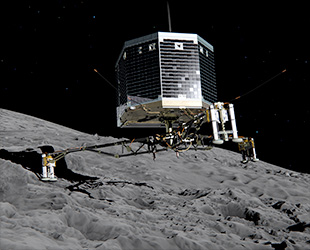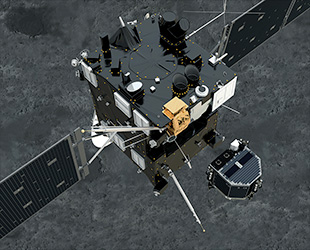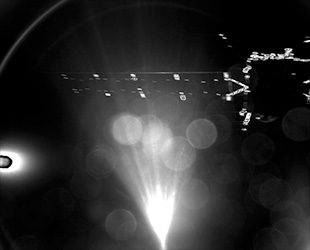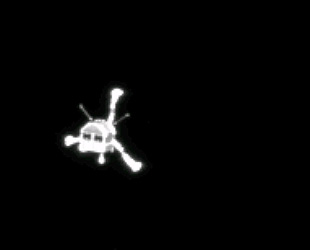November 12, 2014 – A small European space probe has become the first manmade object in history to touch down on the surface of a comet
And it may have done it twice.
Philae, the European Space Agency's three-legged lander, successfully fell to the surface of Comet 67P/Churyumov-Gerasimenko after a seven-hour, suspenseful descent on Wednesday (Nov. 12). The unprecedented touchdown was confirmed at 11:03 a.m. EST (1603 GMT), 28 minutes and 20 seconds after it occurred, given the time needed for the lander's signal to reach Earth.
"We're there and Philae is talking to us," Stephan Ulamec, the director of the Philae landing team at the DLR German Aerospace Center, said just moments after cheers erupted in the control room. "We are sitting on the surface. We are on the comet."
The confirmation was relayed via ESA's Rosetta orbiter to Earth and picked up simultaneously by its ground station in Argentina and NASA's station in Spain. The signal was confirmed at ESA's Space Operations Center (ESOC) and DLR's Lander Control Center, both in Germany.

Artist rendering of the Philae probe landing on the comet. (ESA) |
But soon after proclaiming a successful landing, telemetry from the probe raised questions about the status of Philae on the surface.
"It's not only complicated to land [on a comet], it also as it appears is complicated to understand what has happened during this landing or after this landing," Ulamec stated. "What we know is that it touched down. So, we landed on the comet at the time you all saw us cheering when it was announced. We had a very clear signal there and we also received data from the lander, housekeeping data and also science data."
Philae, which is about the size of a kitchen oven, landed on the smaller of the comet's two irregularly-shaped lobes at a site that was named by public contest "Angilika" after an island in the Nile River. The lander itself was named for an obelisk found on Philae Island also in the Nile, which, with the Rosetta Stone, was instrumental in the translation of Egyptian hieroglyphics.
ESA's Rosetta spacecraft delivered Philae to the comet in August after a decade-long flight from Earth and becoming the first probe to rendezvous with and orbit one of the icy-rocky bodies. Philae and Rosetta separated at 3:35 a.m. EST (0835 GMT) on Wednesday to begin a walking-speed free-fall that led to the touchdown.

Artist rendering of Philae dropping away from Rosetta. (ESA) |
Upon reaching the surface, or nucleus, of Comet 67P/C-G, ice screws in each of the probe's feet and two harpoons were meant to lock Philae down. The probe had also been slated to fire an upward-facing cold gas thruster to prevent it from rebounding in the low gravity, but before separating from Rosetta, the descent system could not be activated.
Initial data from the probe indicated that the harpoons had fired as planned, but subsequent telemetry called that into question. It was also unclear if the ice screws deployed.
"The anchoring harpoons apparently did not fire," Ulamec stated, "so the lander is not anchored to the surface. We still do not fully understand what has happened."
Data received from Philae included fluctuations that could be interpreted as the lander having bounced, lifting off the comet and turning before slowly settling back down some two hours later.
"So maybe today, we didn't just land once," Ulamec said. "We landed twice."

The Philae lander took this parting shot of its mothership Rosetta shortly after separating to descend to the comet. (ESA) |
More may be known by tomorrow morning, he added.
Five minutes after landing for the first time, Philae was to begin taking photos of its new surroundings, which were to immediately be relayed to Rosetta in orbit for transmission to Earth. The first image returned was taken as the lander approached the comet.
"This image was taken at a distance of 3 kilometers from the nucleus," stated Stefano Mottola, principal investigator for the Rosetta Lander Imaging System (ROLIS). "On the top side, we see a leg from the lander, which is in the field of view. The landing site is directly in the middle."
The Philae spacecraft has enough battery power for its 10 science instruments to operate for the next 64 hours. After that, assuming its solar panels can be oriented and they are not obscured by dust, it should able to perform about an hour of observations every couple of days until March, when it is expected Philae will overheat due to the comet approaching the sun and its surface becoming too hot.

Rosetta’s OSIRIS narrow-angle camera captured this parting shot of the Philae lander after the two probes separated. (ESA) |
In addition to cameras and remote sensing instruments, Philae is also outfitted with a drill, a sample collector and a suite of sensors to analyze the physical and molecular composition of the comet. The 220-pound (100 kilogram) ESA lander carries three NASA payloads to study how the comet develops its coma and tail, and how its chemicals interact with radiation and the solar wind.
For the next few months, Philae and Rosetta will conduct joint studies of Comet 67P/C-G, searching for evidence of water and signs of organics that could have given rise to life on Earth. After the lander ceases functioning, Rosetta will continue to collect data until at least the end of 2015.
